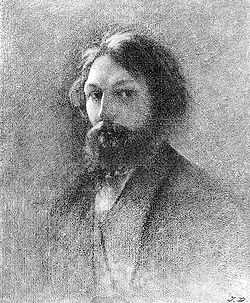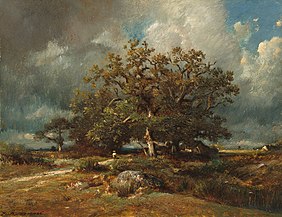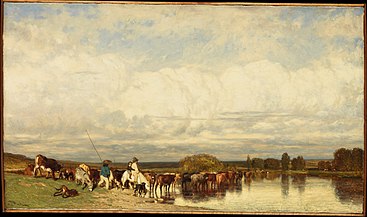Jules Dupré
- Machine translation, like DeepL or Google Translate, is a useful starting point for translations, but translators must revise errors as necessary and confirm that the translation is accurate, rather than simply copy-pasting machine-translated text into the English Wikipedia.
- Consider adding a topic to this template: there are already 6,202 articles in the main category, and specifying
|topic=will aid in categorization. - Do not translate text that appears unreliable or low-quality. If possible, verify the text with references provided in the foreign-language article.
- You must provide copyright attribution in the edit summary accompanying your translation by providing an interlanguage link to the source of your translation. A model attribution edit summary is
Content in this edit is translated from the existing French Wikipedia article at [[:fr:Jules Dupré]]; see its history for attribution. - You may also add the template
{{Translated|fr|Jules Dupré}}to the talk page. - For more guidance, see Wikipedia:Translation.
Jules Dupré | |
|---|---|
 Self-portrait painted in 1853 | |
| Born | (1811-04-05)April 5, 1811 Nantes |
| Died | October 6, 1889(1889-10-06) (aged 78) |
| Nationality | French |
| Known for | Landscape paintings |
| Notable work | Morning and Evening at the Louvre Crossing the Bridge in the Wallace Collection |
| Movement | Barbizon school |
Jules Louis Dupré (April 5, 1811 – October 6, 1889) was a French painter, one of the chief members of the Barbizon school of landscape painters. If Corot stands for the lyric and Rousseau for the epic aspect of the poetry of nature, Dupré is the exponent of its tragic and dramatic aspects.[1]
Biography
Dupré was born in Nantes. He exhibited first at the Salon in 1831, and three years later was awarded a second-class medal. In the same year, he came to England where he was impressed by the genius of Constable. From then on, he learned how to express movement in nature; and the districts around Southampton and Plymouth, with their wide, unbroken expanses of water, sky and ground, gave him good opportunities for studying the tempestuous motion of storm-clouds and the movement of foliage driven by the wind. He was named an Officer of the French Légion d'honneur in 1848.[1] His daughter Therese-Marthe-Francoise also became a painter.
Dupré's colour is sonorous and resonant. He showed preference for using dramatic sunset effects and stormy skies and seas as the subjects of his paintings. Late in life he changed his style and gained appreciably in largeness of handling and arrived at greater simplicity in his colour harmonies. Among his chief works are the Morning and Evening at the Louvre, and the early Crossing the Bridge in the Wallace Collection.[1]
Selected paintings
-
 The Windmill (1850s)
The Windmill (1850s) -
 The Old Oak (1870) National Gallery of Art.
The Old Oak (1870) National Gallery of Art. -
 Cows Crossing a Ford, an early work in the collection of the Metropolitan Museum of Art.
Cows Crossing a Ford, an early work in the collection of the Metropolitan Museum of Art. -
 On the Road (1856)
On the Road (1856)
References
 This article incorporates text from a publication now in the public domain: Chisholm, Hugh, ed. (1911). "Dupré, Jules". Encyclopædia Britannica (11th ed.). Cambridge University Press.
This article incorporates text from a publication now in the public domain: Chisholm, Hugh, ed. (1911). "Dupré, Jules". Encyclopædia Britannica (11th ed.). Cambridge University Press.
- ^ a b c Chisholm, Hugh, ed. (1911). Encyclopædia Britannica (11th ed.). Cambridge University Press.
External links


- Environs de Plymouth - Rehs Galleries' biography on Jules Dupré and an image of his early painting Environs de Plymouth.
- Degas: The Artist's Mind, exhibition catalog from The Metropolitan Museum of Art fully available online as PDF, which contains material on Jules Dupré (see index)
















